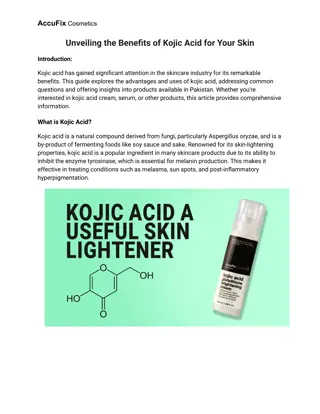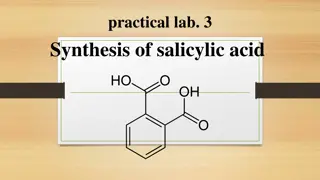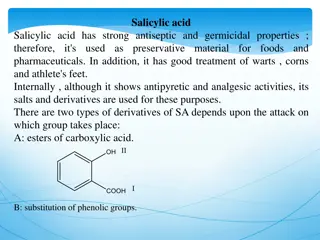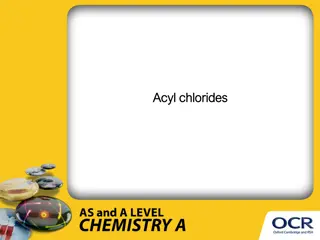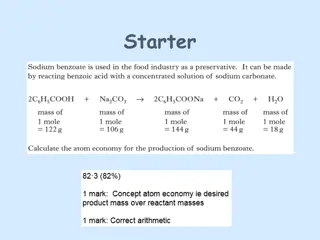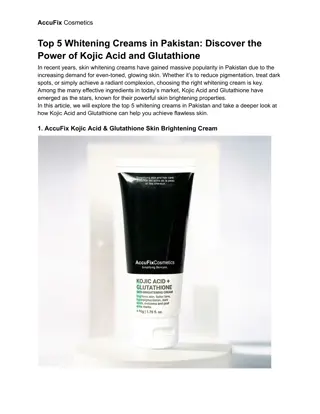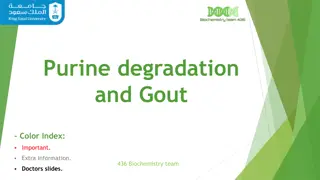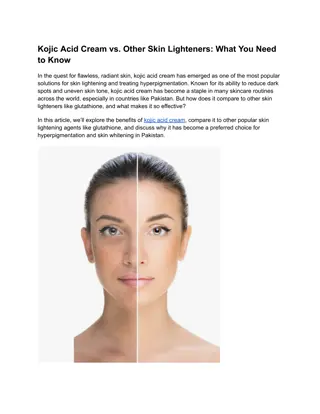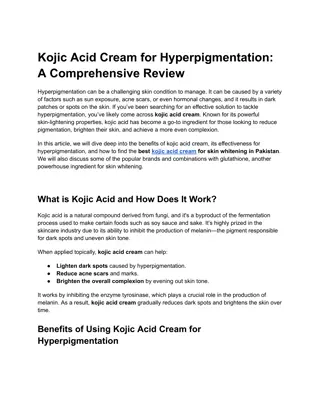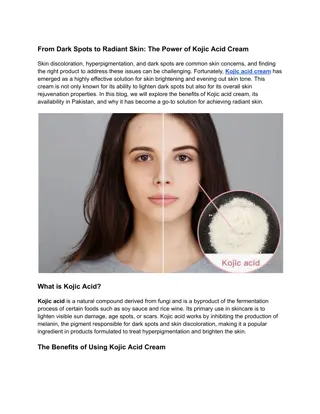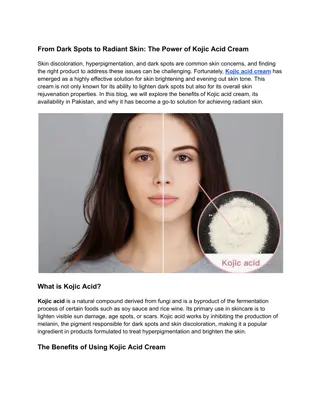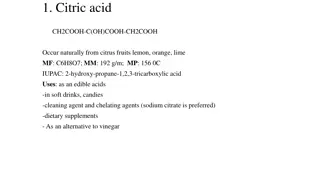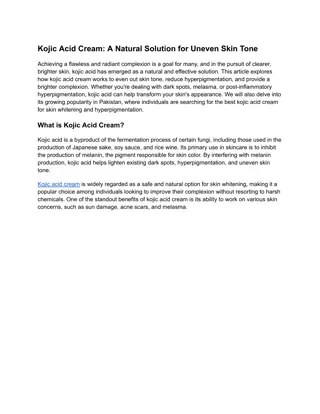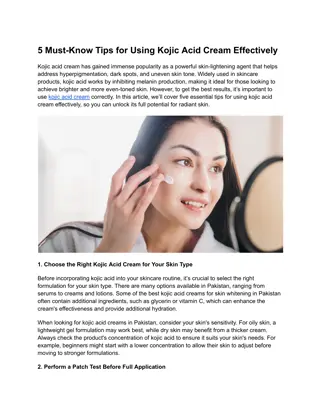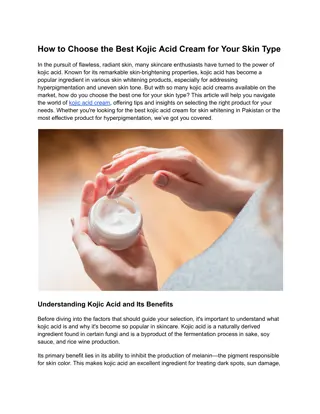
Skin Whitening Agents: Natural Solutions without Harsh Side Effects
Explore the drawbacks of conventional bleaching agents like hydroquinone and mercury compounds, and discover the benefits of natural skin whitening products. Learn about the inhibition of tyrosinase for skin whitening and the effectiveness of kojic acid as a competitive inhibitor. Find out how natural products can offer a safer alternative for achieving brighter skin without the harmful effects associated with synthetic chemicals.
Download Presentation

Please find below an Image/Link to download the presentation.
The content on the website is provided AS IS for your information and personal use only. It may not be sold, licensed, or shared on other websites without obtaining consent from the author. If you encounter any issues during the download, it is possible that the publisher has removed the file from their server.
You are allowed to download the files provided on this website for personal or commercial use, subject to the condition that they are used lawfully. All files are the property of their respective owners.
The content on the website is provided AS IS for your information and personal use only. It may not be sold, licensed, or shared on other websites without obtaining consent from the author.
E N D
Presentation Transcript
KOJIC ACID ESTERS AS SKIN WHITENING AGENTS BY: Alina Patel Aneesh Deshmukh
Popularly used bleaching agents What are Bleaching Creams? Bleaching creams are a cosmetic treatment to reduce the prominence of skin discolorations and even out the color of the skin. Commonly used bleaching agents in bleaching creams H2O2 Hydroquinone (Monobenzone) Mercury Compounds( Chlorides and ammoniates) Vitamins 2
Disadvantages of conventional bleaching agents Hydroquinone may cause unwanted and untreatable skin discoloration and has mutagenic properties and has currently been banned in many countries[1] Mercury compounds pose toxicity in the human body and cause mercury poisoning leading to various ailments.[2] One study states that bleaching agents such as H2O2 regularly need about 10-15% concentration to exhibit whitening effects [3] These high concentrations of H2O2 cause extreme irritation of skin and is very caustic if it gets in your eyes or any other mucosal membrane. Long term skin damage, sensitivity to sun and impaired healing from skin injury are just some of the disadvantages with these 3
Natural products as a solution!!! Several natural products have been discovered which exhibit skin whitening effects without the extreme side effects of conventional bleaching agents One major advantage being the marketing angle, where the consumers are more likely to buy bleaching agents derived from natural products rather than their synthetic chemical counterpart 4
Inhibition of Tyrosinase for skin whitening Tyrosinase , a copper-containing enzyme, catalyzes two distinct reactions during the biosynthesis of melanin. The second one being conversion of Dopaquinone to Eumelanin. Therefore, the regulation of melanin synthesis via the inhibition of tyrosinase is a current research topic in the context of skin whitening. 5
Kojic Acid Kojic acid, the most intensively studied inhibitor of tyrosinase, was discovered by K. Saito in 1907. Kojic acid is one of the metabolites produced by various fungal strains such as aspergillus. It is a by-product in the sake(rice wine) industry in Japan. It is a competetive inhibitor of tyrosinase. [4] It can be created synthetically but is usually created by fermentation of fungi. Certain studies have shown that creams with 1% Kojic acid have had similar effects as 4% hydroquinone.[5] 6
In addition to its skin whitening ability Kojic Acid is a multi faceted compound exhibiting various traits.[6] Anti-Bacterial Anti-Aging Anti-Fungal Antioxidant
Even though Kojic acid is relatively easy to synthesize or obtain from fermentation, there are problems related to the stability of Kojic acid in formulations. Kojic Acid is highly reactive and degrades in solutions. It s instability to light and heat, and the color variation is also a concern. Kojic acid is not oil soluble, prohibiting it to be directly incorporated in oil base cosmetic creams 9
Solutionsto the Problem! 1. Stabilizing Kojic Acid by using Sodium Metabisulphites, Propyl Gallate and other antioxidants.[7] 2. Synthetic derivatives of Kojic acid for improved properties.[6] 10
Kojic Acid Esters Long chain fatty acids can be combined with Kojic acid to improve its stability and solubility. With regards to its activity on Tyrosinase, studies have shown that Esters of Kojic Acid with Palmitic Acid, Oleic Acid and Lauric Acid are potent inhibitors of Tyrosinase and exhibit skin whitening properties.[8] Moreover toxicity studies on them have shown that they are safe to use in cosmetic formulations[9] 11
Synthetic and Cost Viability 1. 2. 3. Kojic Acid Esters are relatively easy to make synthetically Steps involved are: Reacting PCl3 with fatty acid to obtain fatty acid chloride. Reacting kojic acid with fatty acid chloride to obtain a crude product Recrystallizing to obtain kojic acid Ester. Kojic Acid Dipalmitate is the most commonly used Ester for skin whitening purposes but seeing the viability of other derivatives, based on the cost of raw materials, other Kojic acid esters such as Dilaurates or Dioleates can be explored as alternatives, to get the same efficacy while reducing costs. 12
Exploring new compounds A myriad of Kojic Acid derivatives have been synthesized and have been reported to have better inhibition of Tyrosinase compared to its parent molecule For example a ethylene linked di Kojic acid shows 8 times more activity at non-toxic concentrations. [10] Future avenues at using such novel derivatives can also be looked at 13
Choice of Ingredients for Formulation Kojic Acid Dipalmitate is one of the most used natural ingredients for skin whitening. Palmitoyl Chloride as a raw material is quite (~10 times) expensive as compared to Lauroyl Chloride.[11] And thus one would expect Kojic Acid Dilaurate to be comparatively cheaper than Kojic Acid Dipalmitate. Both the alternatives though show excellent solubility in oil phase owing to stable and soluble formulation. 14
Prototype Formula OIL PHASE WATER PHASE Kojic Acid Dilaurate Butylated Hydroxy Anisole Beeswax Stearic Acid Paraffin Oil Vitamin C Vitamin E 3% 0.1% 3% 9% 7% 0.5% 0.5% Glycolic Acid Glycerin Disodium EDTA Sodium Bisulphite TEA Water 10% 1% 0.05% 0.1% 2% q.s. The method of preparation would involve hot mixing; mixing both phases at around 75-80 degree Celsius and then letting the resulting emulsion cool under constant stirring 15
Strength Natural product tag Safe for skin use Versatility in formulation due to analogs of KA Weakness Causes mild irritant effect Costly compared to H2O2 SWOT Analysis Opportunities Novel KA esters Combination of other natural products Threats KA used by itself not stable.
Conclusion Thus Kojic Acid esters are a viable alternative as a skin whitening agent as compared to traditional bleaching agents. 1. From marketing standpoint it stands at a higher ground as: It can be marketed as naturally derived thus attracting customers on basis of its organic nature As Kojic Acid has anti-bacterial/fungal/oxidant/aging properties it can marketed as a 5 in 1 cream. 2. Relatively more expensive than traditional agents such as H2O2 but can emulate similar results with lower harmful effects and better long term effects. 17
References 1. Akortha, E., Niemogha, M., & Edobor, O. (2012). Mutagenic and Genotoxic Screening of Eight Commonly used Skin Whitening Creams in Nigeria. BayeroJournal of Pure and Applied Sciences, 5(1). doi:10.4314/bajopas.v5i1.2 2. Claudia P. Peregrino, MyriamV. Moreno, Silvia V. Miranda, Alma D. Rubio, Luz O. LealInt J Environ Res Public Health. 2011 Jun; 8(6): 2516 2523. Published online 2011 Jun 23. doi: 10.3390/ijerph8062516] 3. Hydrogen peroxide [MAK Value Documentation, 2010]. (2012). The MAK-Collection for Occupational Health and Safety, 192 214. doi:10.1002/3527600418.mb772284e0026 4. Chang, T.-S. (2009). An Updated Review of Tyrosinase Inhibitors. International Journal of Molecular Sciences, 10(6), 2440 2475. doi:10.3390/ijms10062440 5. Sarkar, R., Arora, P., & Garg, Kv. (2013). Cosmeceuticalsfor hyperpigmentation: What is available? Journal of Cutaneous and Aesthetic Surgery, 6(1), 4. doi:10.4103/0974-2077.110089 6. Balakrishna, C., Payili, N., Yennam, S., Uma Devi, P., & Behera, M. (2015). Synthesis of new kojic acid based unnatural -amino acid derivatives. Bioorganic & Medicinal Chemistry Letters, 25(21), 4753 4756. doi:10.1016/j.bmcl.2015.07.099 7. Isaacs, E.; Isaacs, D. Composition to Stabilise Kojic Acid. U.S. Patent Application US 13/728,973, 27 December 2012. 8. Lajis, A. F. B., Hamid, M., & Ariff, A. B. (2012). Depigmenting Effect of Kojic Acid Esters in HyperpigmentedB16F1 Melanoma Cells. Journal of Biomedicine and Biotechnology, 2012, 1 9. doi:10.1155/2012/952452 9. Burnett, C. L., Bergfeld, W. F., Belsito, D. V., Hill, R. A., Klaassen, C. D., Liebler, D. C., Andersen, F. A. (2010). Final Report of the Safety Assessment of Kojic Acid as Used in Cosmetics. International Journal of Toxicology, 29(6_suppl), 244S 273S. doi:10.1177/1091581810385956 10. Lee, Y. S., Park, J. H., Kim, M. H., Seo, S. H., & Kim, H. J. (2006). Synthesis of Tyrosinase Inhibitory Kojic Acid Derivative. Archiv Der Pharmazie, 339(3), 111 114. doi:10.1002/ardp.200500213 11. https://www.sigmaaldrich.com/india.html 18

